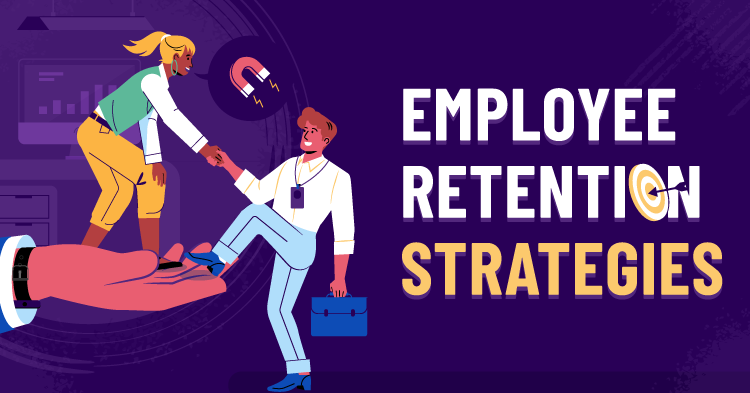17 Employee Retention Strategies to Keep Your Top Talent
A recent survey found that 93% of workers are looking for, or plan to look for, a new job in 2025. So how do you make sure your top talent sticks around?
There are all sorts of reasons why people leave their jobs, from dissatisfaction with their pay to a feeling of being stuck. For a small business, it’s a blow whenever a talented employee hands in their notice — but it’s also a vital opportunity to analyze how your company can do better at keeping your current employees happy, motivated and less likely to leave.
Higher retention rates can boost profitability, prevent high turnover, keep employee morale high and give you a competitive edge. Let’s review what employee retention means, how it works and what talent management strategies you can use to keep your best employees.
17 Effective employee retention strategies to keep your top talent.
1.Focus on culture and employee engagement. Engaged employees are more likely to stay long term, so build a workplace culture that values collaboration, recognition, and inclusion.
2. Conduct exit interviews. When team members leave your company, take the time to sit down with them and conduct an exit interview. Your employees are more likely to be honest with you at this point, and you can gain a lot of insight about the reasons employees leave in one-on-one meetings.
3. Hire the right people. Use thorough screening processes to ensure you’re hiring the right people and that new hires align with your team culture, values and needs.
4. Review your onboarding process. According to an article by Harvard Business Review, 52% of new hires feel undertrained after onboarding, and that number increased to 66% for employees at small companies. It’s important to give new employees the right training and tools, but don’t forget to incorporate your company’s culture, values and mission as well.
5. Train your managers. Good leadership inspires good management which inspires good associate-level employees. One report found that 57% of employees have left a job because of their boss, so be sure to prioritize training initiatives for all of your leaders to support their teams effectively.
6. Emphasize teamwork. Being a part of a team that’s enjoyable to work with and produces great work can inspire loyalty and create a sense of belonging and identity. It also just makes coming to work more enjoyable. You should be sure to recognize top performers, but make sure the team knows you see the work that everyone put in.
7. Evaluate your employees’ compensation. A number of employees leave because they feel they can make more money somewhere else. Are you providing competitive compensation for your industry? Be sure to benchmark your employee benefits package and other non-salary compensation, too. This could be things like healthcare insurance, bonuses, PTO, retirement, etc.
8. Provide perks. Perks are a great way to improve your working environment and provide some less traditional employee benefits. Offer meaningful perks, such as wellness programs, team lunches, fitness memberships or childcare support. Additionally, flexible work arrangements such as hybrid work or remote work can go a long way towards keeping your employees happy.
9. Offer mentorship programs. A lot of people aren’t sure what their career path looks like. Especially when they’re just starting out. You can help employees find the right path within your organization by setting them up with an effective mentor or development program. Good mentorship can greatly improve their employee experience.
10. Prioritize mental health. Encourage employees to take time off if they need it. Create a supportive environment that emphasizes mental health resources and reduces burnout so they can do their best work. Starting a wellness program and prioritizing employee well-being shows that you care about them and want them to stay healthier and happier.
11. Provide a good work-life balance. Encourage employees to unplug and maintain balance to avoid overwork and stress. Employees have lives, families and personal things that need time and attention. A healthy work-life balance can help prevent burnout and improve employees’ day-to-day life.
12. Give and ask for feedback. Feedback is essential to a healthy work environment, but it goes both ways. Open up channels directly or send out employee surveys to help you, and any members of human resources, better understand what you’re doing well and where you could put in some work.
13. Communicate. Maintain transparency and ensure employees feel informed and included in decisions that affect them. If there are big changes or challenges on the horizon, prepare your employees by communicating with them about it. Let them know what the organization’s plan is and what they can expect going forward as a demonstration of trust in your team.
14. Provide a career path. If employees feel like they can’t advance their career in your organization, they may start looking for a new job. A career development path can give employees room for growth and show them what new skills they need to learn to reach the next level.
15. Conduct performance reviews. Use regular reviews to discuss achievements, improvements, evaluations and goals with employees.
16. Invest in professional development. Provide training, workshops or tuition reimbursement to support long-term skill building. You could also set aside a professional development budget to help employees pay for conferences or networking groups.
17. Recognize achievements. Celebrate employee successes, big or small, to show appreciation for their hard work. Employee recognition acknowledges that you see the work that team members are putting in and that you appreciate their dedication. For smaller achievements, a shout out will suffice, but for the big goals a reward may be in order, like extra time off or a monetary bonus.
What is employee retention?
Employee retention is the art of reducing employee turnover by keeping job satisfaction high. Your company culture also plays a big part — and it starts from the top down.
A positive work environment is a big factor in maintaining high employee engagement and retention rates. This involves everything from providing a good work-life balance and competitive benefits and pay, to opportunities for career growth and advancement.
What are the benefits of employee retention?
It saves money. Hiring, training and onboarding good employees costs money. You have to pay for job postings, plus spend time doing interviews and training new employees. In fact, it can take more than six months to see a positive return on investment when hiring a new employee and getting them up to full productivity.
It increases business and employee efficiency. Workers who have been with your company long term know how the company runs. They know the processes they need to complete, inside and out. They can work faster and make better decisions which supports business growth.
It can boost employee satisfaction. People are happier when they feel like they belong. Having an environment where they feel valued and appreciated can increase their sense of loyalty to a company and ensure they’re happy in their job.
It improves customer experience. Keeping customer or client-facing employees around can improve customer experience. People tend to prefer building relationships with your employees instead of seeing a revolving door of new faces and having to build trust all over again.
It can increase your revenue. Your company runs better when you have a low turnover rate. You’re more efficient, your employees are happier and you’ve reduced the cost of always finding and training new hires. All this can translate into higher revenues for your business.
Effective employee retention leads to numerous benefits and more consistent team performance. High retention rates also support stronger relationships within teams and with clients, ensuring continuity and trust.
How to measure employee retention.
To measure employee retention, you simply need to look at the percentage of employees who have been with your company for a fixed period of time. Tracking this metric over time helps organizations identify trends and areas for improvement. For a larger business, you can break this up into teams to see if there are any areas that need special attention.
Employee retention can be measured by using this formula:
Retention Rate (%) = [(Total Employees at the Start – Employees That Left) / Total Employees at the Start] × 100
A good employee retention rate to aim for is about 90% — though this can vary by industry. You may not want to shoot for a 100% retention rate because it might indicate a stagnant workforce with no room for to join your organization or contribute fresh ideas.
Other HR employee retention metrics to watch:
Employee engagement. An engaged employee is less likely to seek other employment. They care about career advancement, learning and growth opportunities and contributing to the company culture.
Employee satisfaction. Employees who feel they’re fairly compensated and that their work is recognized are more likely to stay with your company.
Turnover rate. Employees who leave can also offer you insight. For example, if one manager has a high turnover rate on their team, it could be a sign that you need to look a little closer.
What can small businesses learn from the giants?
Of course, you don’t have to wait for an employee to leave before making talent retention a priority for your small business. Whether you have three employees or fifty, the benefits of creating strong talent retention strategies can’t be overstated. Consider the financial aspect, for one: it’s estimated that replacing an exiting employee costs 1.5x to 2x their annual salary.
So where should the small business owner start? Like with any aspect of running a business, we can look to the world’s biggest and most successful companies for ideas and guidance.
Our infographic below further explores the importance of keeping employees, and how these billion-dollar firms have prioritized talent retention and enacted strategies that your small business can use as a framework, too.

Click here to view in full size
Retention starts with recruitment.
Talent retention starts at the very beginning of the recruitment process. At the interview stage, recruiters should be transparent with a candidate about things like the salary being offered, a typical role progression roadmap and the scope of learning and development opportunities. All of this will ensure that you and a potential employee are on the same page from the get-go.
You may also want to take a look at how quickly a particular candidate has moved on from previous jobs. All of this will ensure that you and a potential employee are on the same page from the get-go.
The Bottom Line
Improving your business’s employee retention requires consistent effort and adaptability. By implementing these strategies, you can foster loyalty, reduce turnover and create a thriving workplace for years to come.
Sources
Ferguson, S; Hoover, M. (2023). Understanding America’s Labor Shortage: The Most Impacted Industries. uschamber.com
Christian, A. (2023). Workers are quiet quitting, and only employers can stop it. bbc.com
Smith, M. (2023). Gen Z and millennials are leading ‘the big quit’ in 2023—why nearly 70% plan to leave their jobs. cnbc.com
LinkedIn. (2023). 2023 Workplace Learning Report. learning. linkedin.com
Arthur J. Gallagher & Co. (2023). 2023 US Workforce Trends Report Series: Organizational Wellbeing. ajg.com
Bamboo HR. (2023). The Definitive Guide to Onboarding. bamboohr.com
Work Institute. (2020). Retention Report: Trends, Reasons & Recommendations. info.workinstitute.com
Dagbo, J; Acuna, S. (2020). Company Culture: Private Equity’s Intangible Value Creation Lever. gallup.com
Achor, S et al. (2018). 9 Out of 10 People Are Willing to Earn Less Money to Do More-Meaningful Work. hbr.org
BetterUp. (2018). Workers Value Meaning at Work; New Research from BetterUp Shows Just How Much They’re Willing to Pay for It. betterup.com
LinkedIn. (2018). 2018 Workplace Learning Report. learning. linkedin.com
Gurchiek, K. (2008). Lack of Career Advancement Main Reason Workers Consider Leaving. shrm.org
Together Mentoring. (2022) Take mentorship to the next level. togetherplatform.com
Spataro, J. (2021). How Microsoft approaches hybrid work: A new guide to help our customers. microsoft.com
Tinypulse. (2018). Employee Retention Report. tinypulse.com
Schwantes, M. (2022). 1 Simple Idea Bill Gates Uses to Hire the Best Employees. inc.com
Dropbox. (2013). Go from idea to done with Dropbox. dropbox.com
Google. (2020). Business editions. support.google.com
QuercusApp. (2017). Why Adobe Abolished the Annual Performance Review. stories.quercusapp.com
Bariso, J. (2020). Netflix’s Unlimited Vacation Policy Took Years to Get Right. It’s a Lesson in Emotional Intelligence. inc.com
Joblist. (2022). How Do Unlimited Vacation Policies Affect Employees? Over 1,000 Employees Weigh In. joblist.com
Fishman, C. (1996). Whole Foods Is All Teams. fastcompany.com
VergeSense. (2021). Office utilization has increased 135% since the start of the pandemic. vergesense.com
Kohll, A. (2019). How Your Office Space Impacts Employee Well-Being. forbes.com
Nike. (2022). Prioritizing Worker Engagement and Wellbeing. nike.com
Barker, L. (2022). 40 Employee Wellbeing Survey Questions to Prevent Burnout. heykona.com
Estrada, S. (2022). Nvidia’s CFO on how they retain tech talent —even as the Great Resignation continues. fortune.com
Ignition Coaching. (2022). What Is The Key To Employee Retention? ignition-coaching.com
Society for Human Resource Management. (2018). SHRM-Globoforce Survey: HR Professionals Indicate Recognition Programs Have Positive Impact on Retention and Recruitment. shrm.org
Workleap. (2014). Statistics on the importance of employee feedback. workleap.com
Lee, S. (2019). 20 employee recognition ideas that work. cultureamp.com
Time Doctor. (2017). Employee retention strategies: 39 companies’ key methods for retaining talent. timedoctor.com
Vuleta, B. (2023). 30 Troubling Employee Retention Statistics. legaljobs.io
Personio. (2021). Building a great career progression framework. personio.com
Hirsch, A. (2017). Don’t Underestimate the Importance of Good Onboarding. shrm.org
Duggan, C. (2017). How to build a new employee onboarding process. resources.workable.com
WTW. (2022). Global Benefits Attitudes Survey 2022. wtwco.com
Framery Acoustics. (2022). Office workers want perks that improve their work-life satisfaction. frameryacoustics.com
Buffer. (2023). State Of Remote Work 2023. buffer.com
Miranda, D; Bottorff, C. (2023). Best Employee Benefits In 2023. forbes.com
DISCLAIMER: This content is for informational purposes only. OnDeck and its affiliates do not provide financial, legal, tax or accounting advice.



